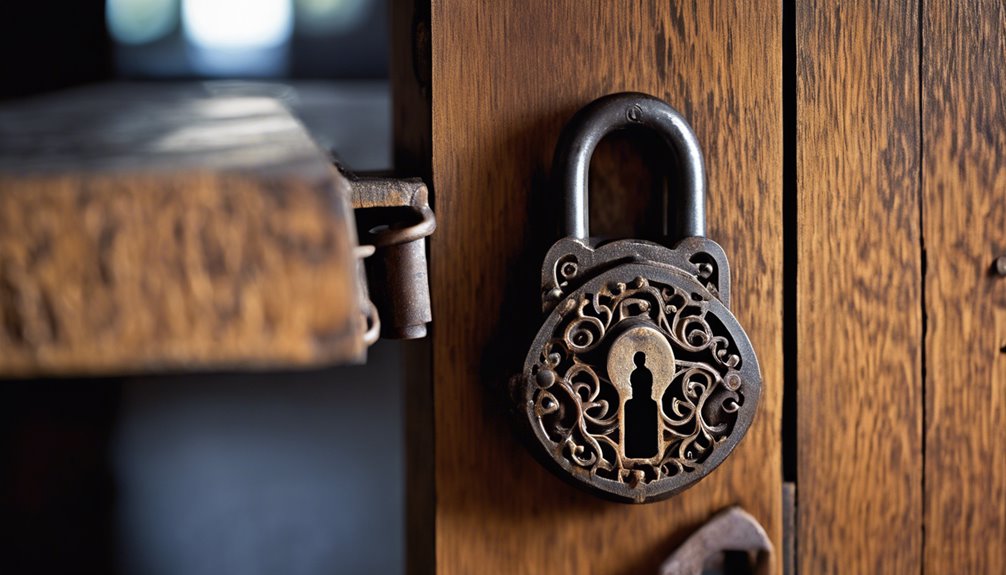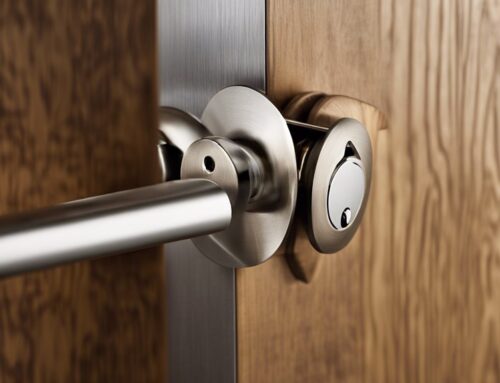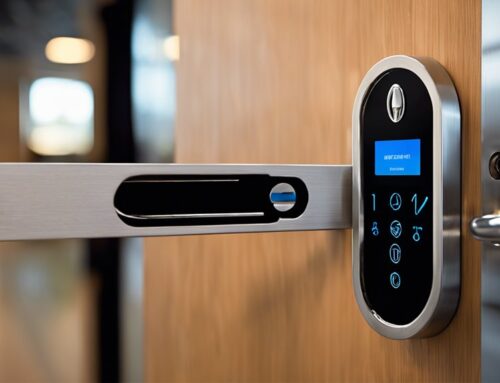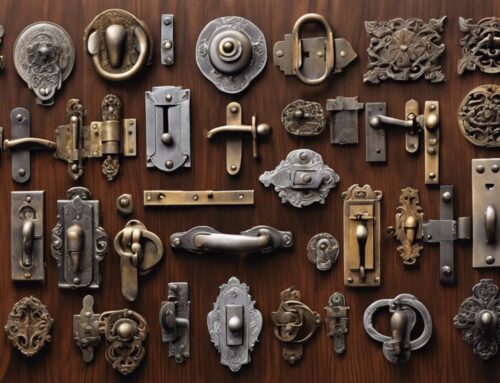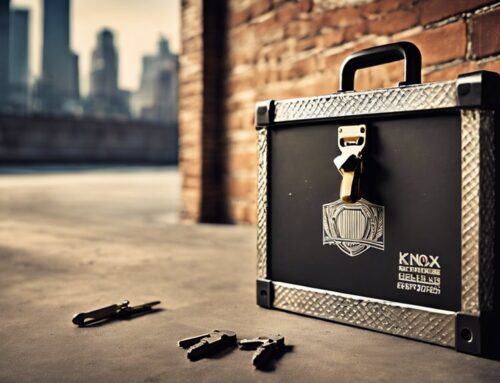When you consider the evolution of security, warded locks stand out as a fascinating intersection of history and modernity. You might initially think of their practical uses in ancient times, but as you dig deeper, you’ll uncover how their simplicity became a double-edged sword. While they once provided reliable protection, the same traits that made them accessible now render them vulnerable. So, how did these mechanisms shift from essential safeguards to low-security solutions in today’s world? The answer may surprise you.
Key Takeaways
- Warded locks originated around 400 BC, evolving through Mediterranean design for security and spreading across Europe during the Middle Ages.
- Their mechanism includes a unique key and wards that prevent unauthorized access by aligning notches for smooth rotation.
- Despite historical significance, warded locks exhibit security vulnerabilities, including susceptibility to simple manipulation and limited key variations.
- Today, they are utilized in low-security applications like storage units and garden gates, balancing historical accuracy with practicality.
- Modern innovations feature advanced lock systems, including pin tumbler designs and electronic locks, offering higher security and user convenience compared to warded locks.
Early History of Warded Locks
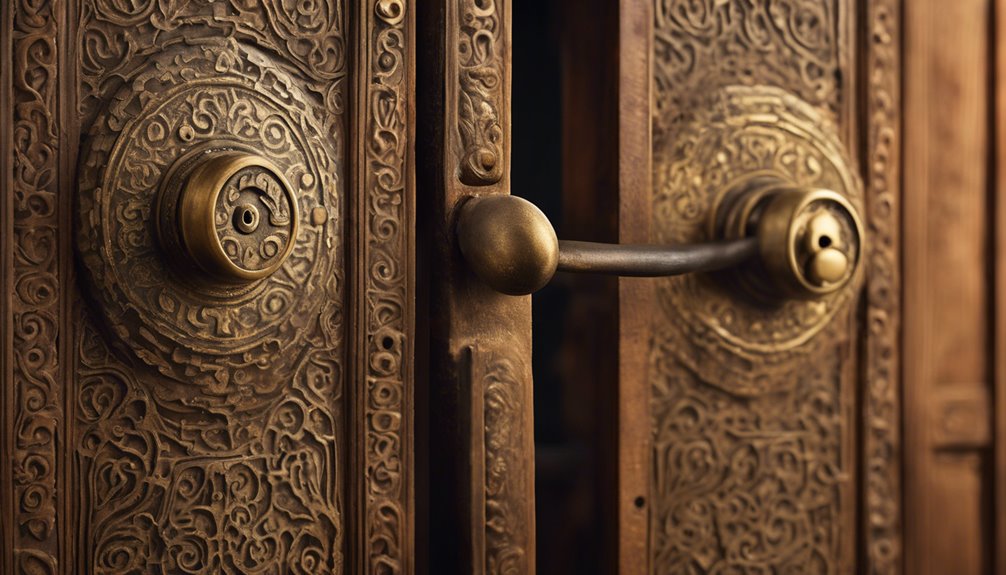
Although you might think of locks as a modern invention, warded locks have a rich history that dates back to ancient times.
Originating in the Mediterranean region around 400 BC, these locks employed a simple yet effective design consisting of a key and a body with wards or obstructions. The key’s unique shape allowed it to bypass these wards, thereby enabling access to secured spaces.
The innovation was significant; it marked a shift from rudimentary locking mechanisms to more sophisticated systems, establishing a standard for security.
The popularity of warded locks spread throughout Europe during the Middle Ages, evolving as artisans refined their construction.
Understanding this evolution is essential for mastering the intricacies and implications of locking mechanisms in history.
Mechanism and Principles

When you examine warded locks, understanding the alignment of key notches is essential for their operation. Each component, from the key to the warded mechanism, plays an important role in determining both functionality and security.
However, as you’ll see, these locks also have inherent limitations that can compromise their effectiveness.
Key Notch Alignment
Key notch alignment is fundamental to the functionality of warded locks, as it directly influences how the key interacts with the lock mechanism.
When you insert the key, the notches must align precisely with the corresponding wards inside the lock. This alignment permits the key to rotate smoothly, lifting the bolt and granting access.
If the notches are misaligned, the wards obstruct the key’s movement, preventing the lock from opening.
Each notch’s depth and position are meticulously designed to create a unique profile for the key, ensuring that only the correctly shaped key can engage with the internal structure.
Mastering this intricate relationship between key and ward allows for a deeper appreciation of warded lock mechanics and their historical significance.
Lock Components Overview
Understanding the components of a warded lock reveals the intricate mechanisms that define its operation and security.
At its core, a warded lock consists of a cylinder, a series of wards, and a matching key. The cylinder houses pins or levers that interact with the key, while the wards act as barriers against incompatible keys.
As you insert the key, its notches align with the wards, allowing the cylinder to turn and disengage the locking mechanism. The arrangement and design of these wards are essential; they determine which keys can successfully operate the lock.
Security Limitations Explained
While warded locks showcase sophisticated mechanical artistry, their security limitations are notable and stem from both their design and operational principles. The fundamental concept of the warded lock relies on the alignment of a key with internal wards, which inherently exposes it to vulnerabilities. Here’s a closer look at the key limitations:
| Limitation | Description |
|---|---|
| Wards | Easily manipulatable with simple tools |
| Complexity | Limited number of combinations possible |
| Material | Often made from softer metals, leading to wear |
| Resistance to Bumping | Minimal, can be bypassed using basic techniques |
| Key Duplication | Simple keys can be easily duplicated |
Understanding these factors illuminates the inherent weaknesses in warded locks, emphasizing the necessity for evolving security solutions. High-security locks, unlike warded locks, incorporate advanced mechanisms such as unique key designs that significantly enhance their resistance to unauthorized access. Moreover, enhanced tamper resistance in high-security locks provides substantial protection against the vulnerabilities seen in warded locks.
Historical Significance
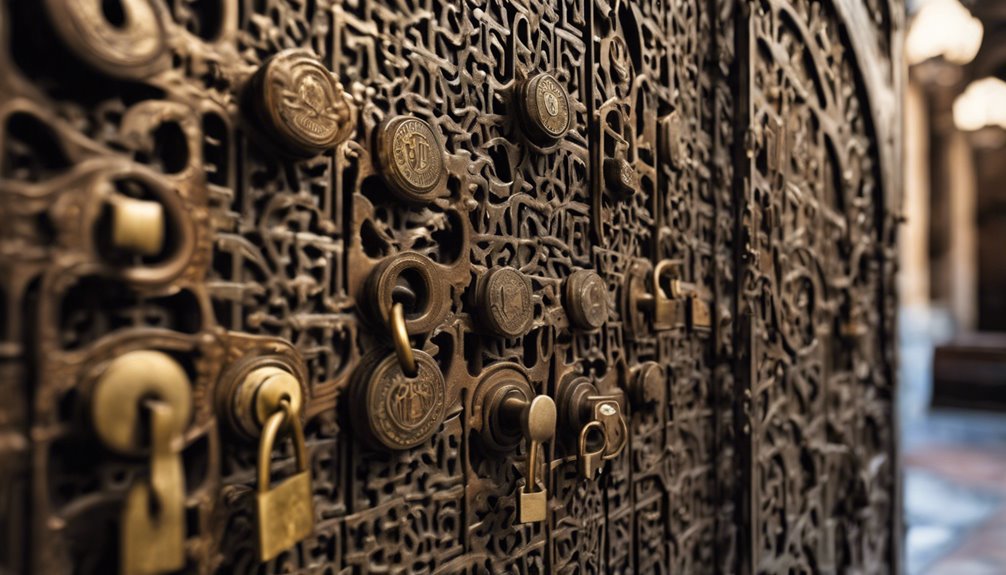
The evolution of warded locks offers a fascinating glimpse into the development of security mechanisms throughout history. Originating in ancient civilizations, these locks symbolize the intersection of craftsmanship and societal needs for safety.
You’ll notice that warded locks reinforced the concept of privacy and ownership, emerging during a time when personal property was increasingly valued. Their design, characterized by a set of wards that restricted unauthorized access, reflects a growing sophistication in lock-making techniques.
As these locks spread across Europe, they played a central role in shaping legal frameworks surrounding theft and property rights. Understanding their historical significance not only demonstrates technological advancement but also highlights society’s evolving relationship with security and privacy throughout centuries.
Modern Applications
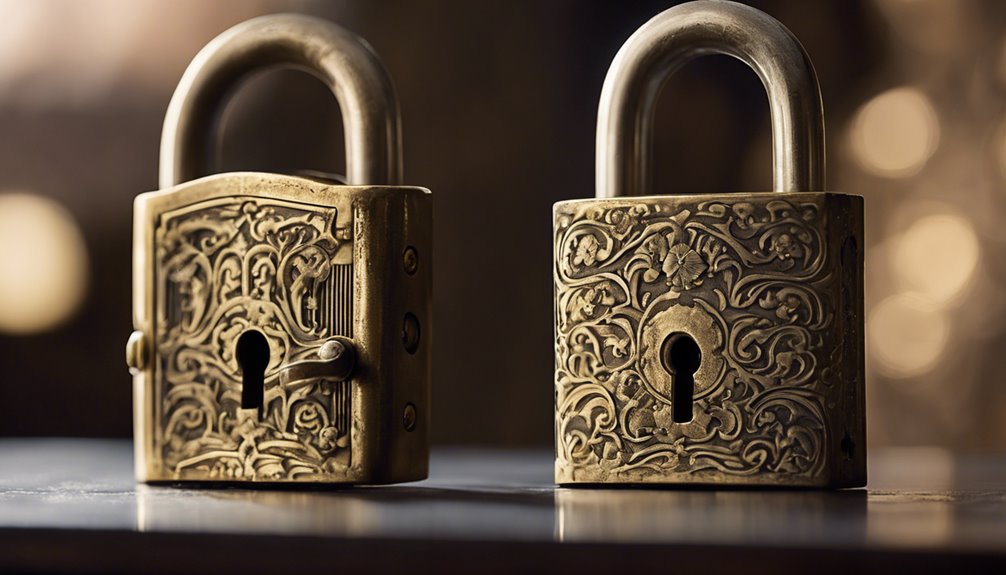
In today’s world, warded locks primarily serve low-security functions, often found in lighter applications where theft is less of a concern.
Their unique design also plays an important role in preserving heritage sites, offering a blend of historical accuracy and functionality.
However, it’s vital to recognize their vulnerabilities and limitations, especially when higher security measures are required in modern contexts.
Low-Security Utilization
Low-security warded locks continue to find their place in various modern applications, particularly where convenience outweighs the need for robust security.
You’ll spot these locks in use at storage units, garden gates, and some interior doors, where the primary goal is to deter casual entry rather than prevent serious burglary. Their simple design promotes ease of use; you can quickly open them without fumbling with complex key mechanisms. In circumstances where quick access is essential, re-keying solutions can be particularly beneficial in mitigating the risk of unauthorized entry.
Curiously, in settings like schools or offices, they facilitate efficient access for multiple users, often requiring minimal keys.
However, while they offer practicality, inherent vulnerabilities make them less ideal for high-stakes environments. Understanding these limitations allows you to make informed choices regarding security solutions tailored to your specific needs. Regular lock maintenance is crucial to ensure they continue to function optimally and to identify any signs of lock deterioration that may necessitate replacement.
Heritage Site Preservation
While warded locks may seem simplistic, their role in heritage site preservation demonstrates their value in safeguarding historical structures without compromising their integrity.
These locks are designed to blend seamlessly with architectural aesthetics, ensuring that the historical narrative of a site remains undisturbed. By employing warded locks, you maintain both accessibility and security, allowing authorized individuals to engage with history while deterring potential threats.
Their mechanical simplicity can also minimize the risk of damage during unauthorized tampering, preserving the architectural elements that define these sites. Additionally, using materials that match or complement original structures strengthens the preservation effort, enhancing overall historical authenticity.
In this way, warded locks affirm their relevance in modern preservation practices, bridging the past with present security needs.
#
Vulnerabilities and Limitations
Although warded locks serve an important purpose in historical contexts, they exhibit significant vulnerabilities in modern applications.
These vulnerabilities stem from their simplicity and design, making them less suitable for today’s security needs. Here are key limitations you should consider:
- Easily Picked: Their basic mechanism allows skilled thieves to manipulate them with simple tools.
- Limited Key Variety: The design restricts the number of unique keys, increasing the risk of unauthorized copies. This is particularly concerning because a lack of unique key designs can easily lead to unauthorized duplication.
- Non-Complexity: Lacking advanced features, they provide minimal resistance to forced entry.
- Susceptibility to Bumping: A technique often used to open these locks quickly undermines their effectiveness. Additionally, using bump-resistant locks can significantly reduce vulnerability to this type of attack.
## Vulnerabilities and Limitations

Despite their historical significance, warded locks possess inherent vulnerabilities that modern technology and advanced techniques have largely exploited.
Their simplistic design, characterized by vertical wards restricting key shape, makes them susceptible to several forms of manipulation. You might find that techniques such as lock picking and key bumping can easily compromise these locks, as the wards offer limited resistance to skilled intruders. In contrast, modern locks utilize tumblers for increased security, making them more challenging to bypass.
Moreover, since these locks rely on specific key profiles, unauthorized duplication poses another risk. The lack of complex internal mechanisms means they provide minimal security against sophisticated attacks, including impressioning.
As a master locksmith, understanding these limitations is essential, as it informs the selection of superior security devices for environments where resistance to theft is paramount. Additionally, recognizing the vulnerabilities of low-quality locks is crucial when assessing security needs.
Comparison to Modern Locks
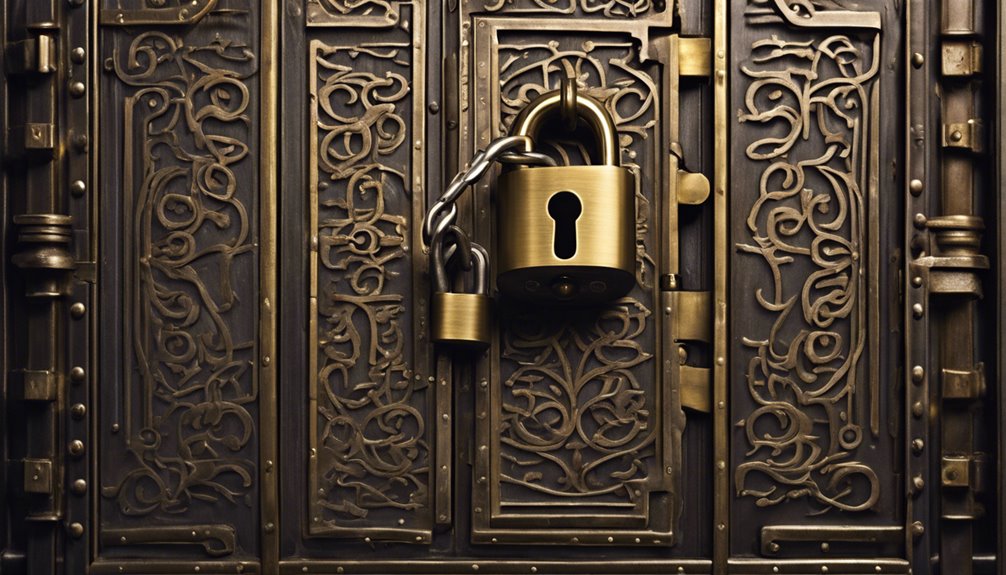
When comparing warded locks to modern locking mechanisms, you’ll quickly notice the stark contrasts in both security features and design sophistication.
Warded locks, primarily designed for ease of use, lack the advanced security provided by contemporary locks. Here are four key differences you should consider:
- Complexity: Modern locks utilize intricate pin tumbler systems or electronic components, increasing resistance to unauthorized entry.
- Material: Today’s locks employ hardened materials and anti-drill features, whereas warded locks typically use softer metals.
- Key Design: Modern keys can be complex and unique, while warded lock keys are easily replicated.
- Integration: Advanced locks often integrate with security systems, offering remote monitoring capabilities that warded locks can’t provide.
Additionally, modern locks often include increased security features such as keyless entry options, which can enhance home protection. These factors reveal the evolution in security technology and design philosophy over time.
Innovations Over Time
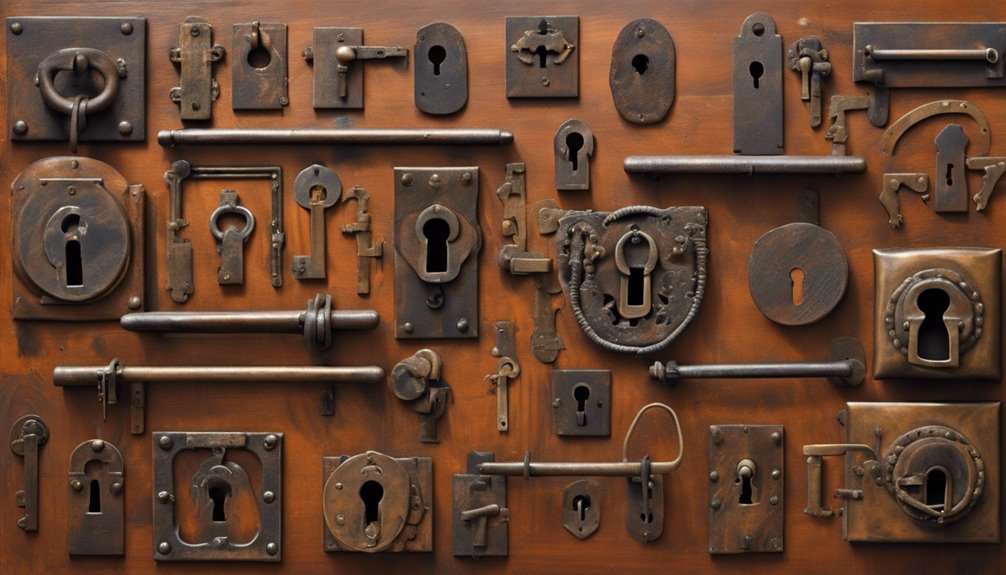
As advancements in technology emerged, the locking mechanisms used throughout history underwent significant innovations that greatly enhanced their functionality and security.
In the quest for more secure locks, makers introduced various complexities in key designs, including unique shapes and integrated mechanisms requiring specific movements. The advent of metallurgy brought about stronger materials, reducing vulnerability to tampering. The incorporation of high-security deadbolts further exemplifies the evolution towards enhanced protection in locking systems.
Additionally, innovations like the introduction of pin tumbler mechanisms allowed for a more nuanced interaction between the key and lock. With the emergence of electronic locks, the traditional mechanics evolved further, seamlessly incorporating digital keypads and biometric systems. Many of these modern systems also incorporate features reminiscent of smart locks that enhance security and convenience.
These shifts not only improved security but also transformed user accessibility, ensuring that you can safeguard your premises with greater reliability and ease.
Heritage Conservation Efforts

With the evolution of locking mechanisms, heritage conservation efforts have gained importance in preserving the rich history of these designs.
You’ll find that understanding their significance involves multiple approaches that guarantee these artifacts are valued correctly. Consider these key strategies:
- Documentation: Archiving blueprints and usage history to maintain records of design evolution.
- Restoration Techniques: Employing traditional methods to restore locks, guaranteeing they’re true to their original craftsmanship. When undertaking restoration, it’s crucial to ensure that the security upgrades applied do not compromise the integrity of the design.
- Public Education: Creating workshops and exhibitions to raise awareness about the cultural significance of warded locks.
- Collaborative Projects: Partnering with museums and heritage organizations for collective preservation initiatives.
Engaging in these efforts not only safeguards the past but also deepens your appreciation of the technological mastery inherent in these mechanisms. Furthermore, when considering lock replacement for preserved sites, it’s essential to choose designs that align with both historical and modern security standards.
Frequently Asked Questions
How Do Warded Locks Compare in Aesthetics to Modern Locks?
When you compare warded locks to modern locks, you’ll notice distinct aesthetic differences.
Warded locks often feature intricate designs, showcasing craftsmanship from a bygone era. Their ornamental keyholes and decorative bodies evoke a vintage charm that modern locks, with their minimalist and utilitarian forms, tend to lack.
While modern locks prioritize security and functionality, warded locks embody artistry, creating a unique blend of history and aesthetics that appeals to collectors and enthusiasts alike.
Can Warded Locks Be Repaired or Modified Effectively?
You might find that repairing a warded lock isn’t as intimidating as it seems.
For instance, if a key breaks inside, you can often extract it with the right tools, restoring functionality.
Modifications, like adding a new set of wards or changing the cylinder, can be effective, though they require precision.
Mastering these techniques not only preserves the lock’s integrity but also guarantees it can continue to function securely in your daily life.
What Are the Common Materials Used to Make Warded Locks Today?
Today, warded locks commonly use materials like brass, steel, and zinc alloys.
Brass offers corrosion resistance and durability, making it a popular choice for both the internal mechanisms and housing. Steel components add strength, while zinc alloys balance cost and durability for budget-friendly options.
When you’re evaluating warded locks, consider how these materials influence not just longevity but also security features, as they directly affect the lock’s resilience against manipulation and wear.
Are There Locksmiths Specialized in Warded Lock Maintenance?
Yes, there are locksmiths who specialize in warded lock maintenance.
You’ll find that these experts are well-versed in the intricacies of warded locks, understanding the unique mechanisms and potential vulnerabilities.
They can offer repairs, key duplication, and restoration services to guarantee your lock operates smoothly.
If you’re looking to maintain your security without compromising on tradition, seeking out a locksmith with this specialization will be essential for preserving the integrity of your warded lock.
What Historical Figures Are Known for Using Warded Locks?
You might be surprised to learn that many historical figures, from medieval European nobility to artisans of the Renaissance, famously employed warded locks for their impressive security features.
Particularly, people like King Richard the Lionheart illustrated their wealth and status with intricate warded locks on their castles.
These locks became a hallmark of safety and craftsmanship, reflecting both the era’s artistry and the necessity for protection against theft and invasion.
Conclusion
As you turn the key in a warded lock, you’re not just opening a door; you’re revealing a slice of history that dates back to ancient times. Yet, like a crumbling castle, its once-mighty defenses have succumbed to modern vulnerabilities. While warded locks served a noble purpose, today’s security landscape demands more robust solutions. Embracing innovations brings us closer to safe havens we can truly rely on, blending the echoes of the past with the promise of the future.

